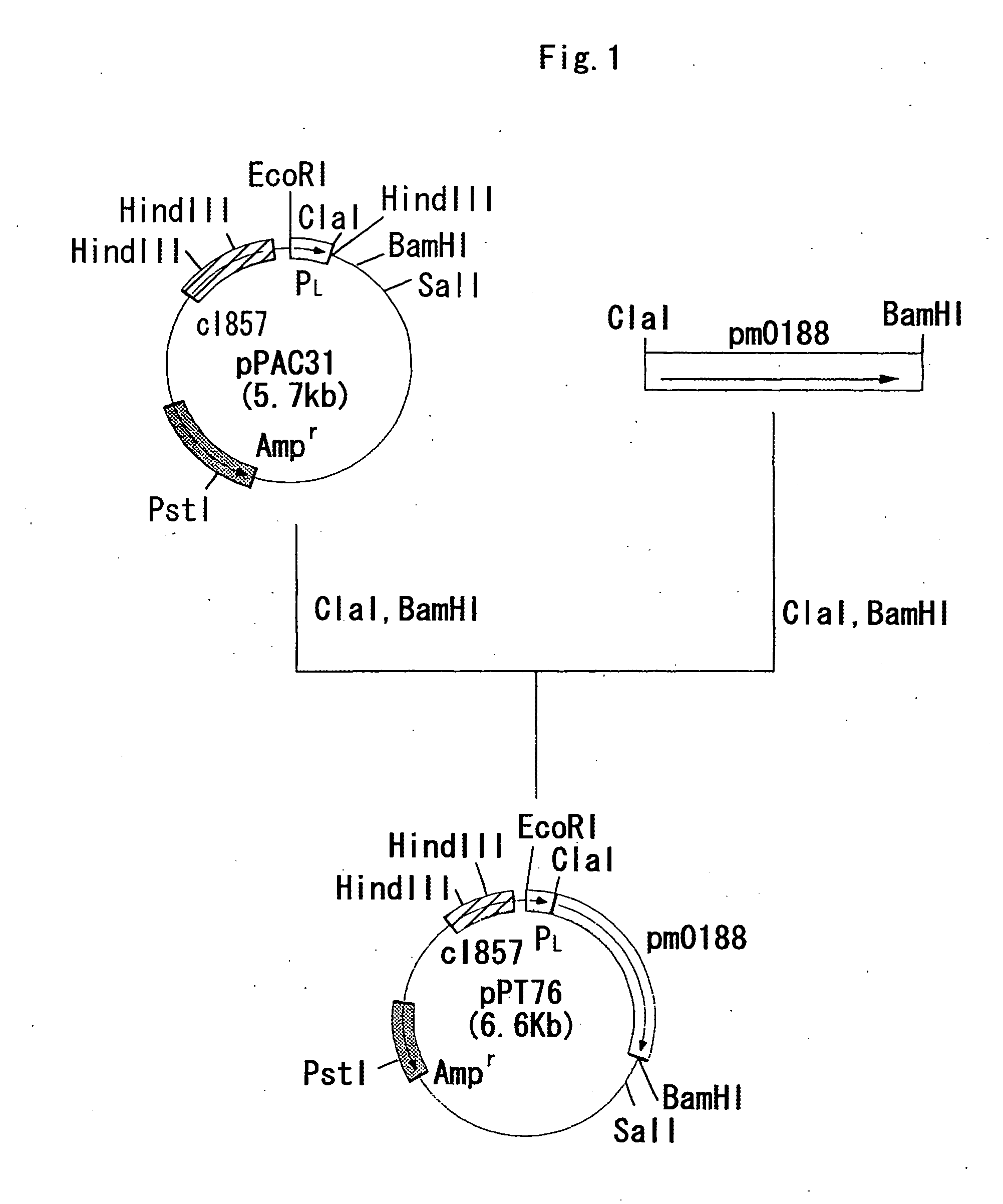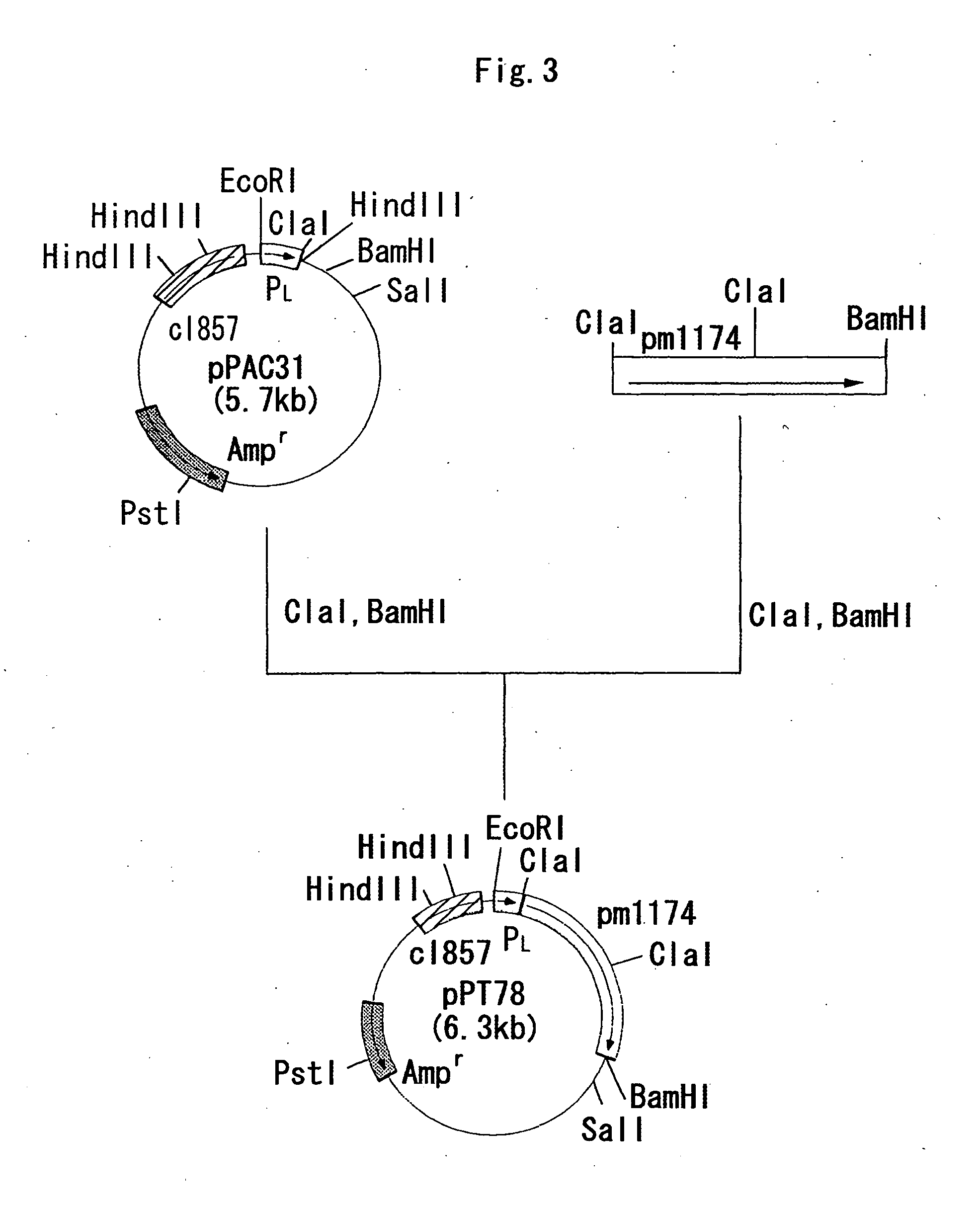Process for producing alpha 2,3/ alpha 2,8-sialyltransferase and sialic acid-containing complex sugar
a technology of sialic acid and complex sugar, which is applied in the direction of transferases, enzymology, organic chemistry, etc., can solve the problem of no report in which the gene is obtained from a microorganism belonging to, and achieve the effect of efficient cultur
- Summary
- Abstract
- Description
- Claims
- Application Information
AI Technical Summary
Benefits of technology
Problems solved by technology
Method used
Image
Examples
example 1
Construction of a Strain Expressing a Gene Encoding an α2,3 / α2,8-Sialyltransferase Derived From Pasteurella Multocida
(1) Construction of Escherichia Coli NM522 / pPT76
[0195] A chromosomal DNA of Pasteurella multocida PM70 was obtained from Minnesota University.
[0196] Using DNA fragments having the nucleotide sequences represented by SEQ ID NOs:7 and 8 which had been synthesized by using a DNA synthesizer Model 8905 manufactured by Perceptive Biosystems, a DNA fragment containing pm0188 considered to be a gene encoding an α2,6-sialyltransferase in the full nucleotide sequence of the genomic DNA in Pasteurella multocida PM70 was amplified by the following method.
[0197] PCR was carried out by using the above synthetic DNA fragments as a primer set and using the chromosomal DNA of Pasteurella multocida PM70 as the template. The PCR was carried out by using 40 μl of a reaction solution containing 0.1 μg of the chromosomal DNA, 0.5 μmol / l of each of the primers, 2.5 units of Pfu DNA po...
example 2
Production of a Sialic Acid-Containing Complex Carbohydrates Using Escherichia Coli NM522 / pPT76
(1) Production of NeuAcα2-3Galβ1-4Glc
[0237]Escherichia coli NM522 / pPT76 obtained in the item (1) of Example 1 was inoculated into a test tube charged with 8 ml of LB medium containing 50 μg / ml ampicillin, followed by culturing at 28° C. for 17 hours. The culture was inoculated into a test tube charged with 8 ml of LB medium containing 50 μg / ml ampicillin, with an inoculum size of 1%, followed by culturing at 28° C. for 2 hours and then at 40° C. for 3 hours. Wet cells were obtained by centrifuging 0.5 ml of the culture. The wet cells can be stored at −20° C., if necessary, and it was able to use them by thawing prior to use.
[0238] The reaction was carried out at 37° C. for 16 hours in 0.1 ml of a reaction solution containing the NM522 / pPT76 wet cells obtained in the above, 50 mmol / l citrate buffer (pH 7.0), 5 mmol / l MnCl2, 10 mmol / l lactose, 5 mmol / l CMP-sialic acid and 4 μl Nymeen S-2...
example 3
Production of Sialic Acid-Containing Complex Carbohydrates Using Escherichia Coli NM522 / pPT79
(1) Production of NeuAcα2-3Galβ1-4Glc
[0254]Escherichia coli NM522 / pPT79 obtained in the item (2) of Example 1 was inoculated into a test tube charged with 8 ml of LB medium containing 50 μg / ml ampicillin, followed by culturing at 28° C. for 17 hours. The culture was inoculated into a test tube charged with 8 ml of LB medium containing 50 μg / ml ampicillin, with an inoculum size of 1%, followed by culturing at 28° C. for 2 hours and then at 40° C. for 3 hours. Wet cells were obtained by centrifuging 0.5 ml of the culture. The wet cells can be stored at −20° C., if necessary, and it was able to use them by thawing prior to use.
[0255] The reaction was carried out at 37° C. for 6 hours in 0.1 ml of a reaction solution containing the NM522 / pPT79 wet cells obtained in the above, 50 mmol / l citrate buffer (pH 7.0), 5 mmol / l MnCl2, 10 mmol / l lactose, 5 mmol / l CMP-sialic acid and 4 g / l Nymeen S-215...
PUM
| Property | Measurement | Unit |
|---|---|---|
| temperature | aaaaa | aaaaa |
| pH | aaaaa | aaaaa |
| pH | aaaaa | aaaaa |
Abstract
Description
Claims
Application Information
 Login to View More
Login to View More - R&D
- Intellectual Property
- Life Sciences
- Materials
- Tech Scout
- Unparalleled Data Quality
- Higher Quality Content
- 60% Fewer Hallucinations
Browse by: Latest US Patents, China's latest patents, Technical Efficacy Thesaurus, Application Domain, Technology Topic, Popular Technical Reports.
© 2025 PatSnap. All rights reserved.Legal|Privacy policy|Modern Slavery Act Transparency Statement|Sitemap|About US| Contact US: help@patsnap.com



